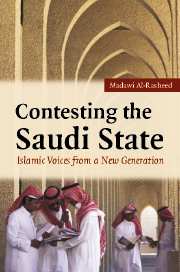Book contents
- Frontmatter
- Contents
- Glossary
- Map
- Introduction: debating religion and politics in the twenty-first century
- 1 Consenting subjects: offcial Wahhabi religio-political discourse
- 2 Re-enchanting politics: Sahwis from contestation to co-optation
- 3 Struggling in the way of God abroad: from localism to transnationalism
- 4 Struggling in the way of God at home: the politics and poetics of jihad
- 5 Debating Salafis: Lewis Atiyat Allah and the jihad obligation
- 6 Searching for the unmediated word of God
- Conclusion
- Notes
- Bibliography
- Index of personal names
- Index of place names
- General Index
- Cambridge Middle East Studies 25
1 - Consenting subjects: offcial Wahhabi religio-political discourse
Published online by Cambridge University Press: 22 September 2009
- Frontmatter
- Contents
- Glossary
- Map
- Introduction: debating religion and politics in the twenty-first century
- 1 Consenting subjects: offcial Wahhabi religio-political discourse
- 2 Re-enchanting politics: Sahwis from contestation to co-optation
- 3 Struggling in the way of God abroad: from localism to transnationalism
- 4 Struggling in the way of God at home: the politics and poetics of jihad
- 5 Debating Salafis: Lewis Atiyat Allah and the jihad obligation
- 6 Searching for the unmediated word of God
- Conclusion
- Notes
- Bibliography
- Index of personal names
- Index of place names
- General Index
- Cambridge Middle East Studies 25
Summary
O ye who believe Obey Allah, and obey the Messenger, and those charged with authority among you. If ye differ in anything among yourselves, refer to God and His Messenger, if ye
Do believe in Allah and the Last Day: that is best, and most suitable for final determination.
Quran, Sura al-nisa, verse 59Eighteenth- and nineteenth-century Wahhabi chronicles claimed that the message of Muhammad ibn Abd al-Wahhab (1703–92) in Deriyyah aimed to revive religion by returning to the Quran, Sunna and the tradition of the pious ancestors. While the sheikh and his followers never accepted the label Wahhabis, they considered themselves to be ahl al-sunna wa ʾl-jama ʿa (people of tradition and community), or ahl al-tawhid (al-muwahhidun: the people of monotheism). In contemporary scholarship, they represent one of the Salafi trends within Sunni Islam. The return to the tradition of the pious ancestors was meant to remove religious innovations, and applythe shariʿa at a timewhen the population of Arabia was believed to have degenerated into blasphemy, corrupt religious practices and laxity. This allegedly took place mainly under Ottoman rule, whose religious traditions, particularly Sufism, incorporated interpretations and practices consideredoutside the realm of true Islam. The rhetoric of the return to the pious ancestorsand the sacred text, in addition to rejecting madhahib (schools of jurisprudence), allows Wahhabiyya to be counted as a Salafi movement.
Wahhabiyya painted an image of Arabia as the land of blasphemy and savagery.
- Type
- Chapter
- Information
- Contesting the Saudi StateIslamic Voices from a New Generation, pp. 22 - 58Publisher: Cambridge University PressPrint publication year: 2006

